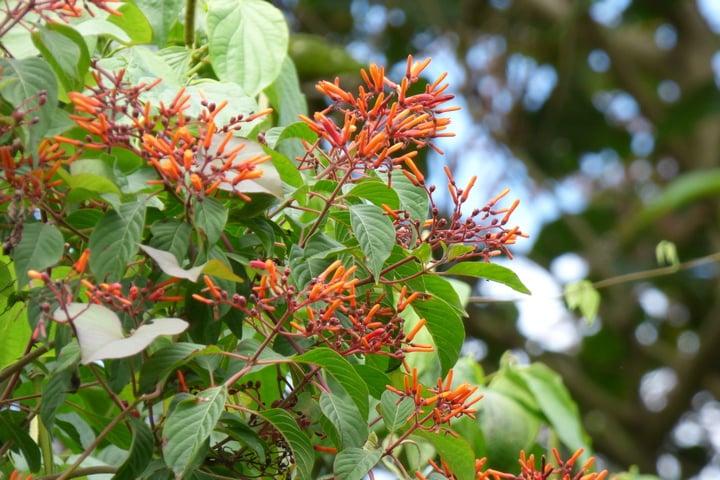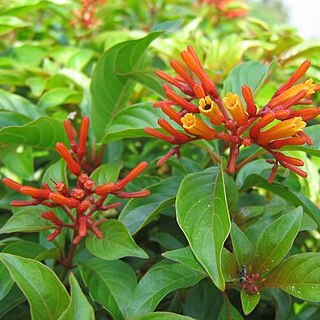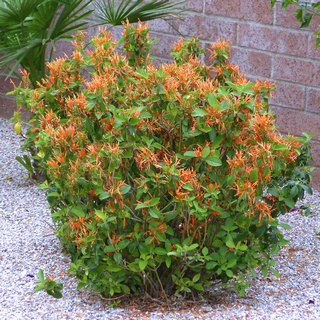Firecracker bush is a tropical-looking shrub that provides year-round color — vivid red-orange flowers and leaves that change from bright green to copper in the fall. Here’s how to grow this native of Latin America.

Firecracker bush (Hamelia patens) is a festive, medium-size shrub with bright green leaves and vivid tubular red-orange flowers. Flowers, which attract hummingbirds, are followed by dark, edible berries that birds of all kinds enjoy.
Even though its native habitat is the tropics and subtropics of the Western Hemisphere, it is a solid performer in the desert, provided it’s protected from the harshest heat and sun. Other than watering, it needs little care.
Why I Like This Plant
- Bright red-orange flowers
- Long bloom season
- Low maintenance, no thorns, low litter
- Fruit attracts birds
- Flowers attract hummingbirds, butterflies
Optimal Growing Conditions
If you’re thinking of adding a firecracker bush to your garden, you need to find a suitable place that will keep your plant healthy and looking good… while minimizing maintenance for you.
Here are the key factors to keep in mind.
Temperature
Firecracker bush should be grown in USDA Hardiness Zones 8 – 11. It tolerates desert heat but should not be grown in the hottest spot in your yard, such as near the reflected heat of a building or garden wall or where it gets full on western sun.
It can survive temperatures down to 10℉, but its leaves will suffer cold damage below 25℉. When grown where winters are mild, it will stay evergreen, but otherwise loses its copper-colored fall leaves after the first frost. Plants rebound quickly in the spring.
Sun Exposure
Firecracker bush does best in part shade or full sun with some afternoon shade. It will struggle where it receives reflected sun, especially along a west-facing wall. In full shade, it won’t produce flowers.
Size and Growth Rate
Firecracker bush is considered a fast grower. In the desert southwest, it typically reaches a size of 3 to 5 feet tall and wide, and flowers from spring through fall.

In areas where it doesn’t die back in the winter, it can grow much larger, up to 15 feet tall. When grown in the tropics, it becomes a small tree.
Soil
Firecracker bush tolerates most desert soils, provided it’s well-draining, but it prefers fertile soil with a moderate to high amount of organic matter.
Other Location Considerations
Since it is non-toxic and has no thorns or irritating hairs, it’s a plant you can place anywhere it might come in contact with people or pets.
Since it prefers rich soil and requires a moderate amount of water, consider growing one in a large container.
Firecracker Bush:
The Essentials
| Common Name | Firecracker bush |
| Scientific Name | Hamelia patens |
| Origin | Florida, Mexico, Central, South America |
| Plant Type | Semi-deciduous shrub |
| USDA Zones | Zones 8 – 11 |
| Cold Hardiness | To 10℉ |
| Flower Color | Red-orange |
| Flower Season | Spring, summer, fall |
| Mature Size | 3-5’ high x 3-5’ wide |
| Growth Rate | Fast |
| Sun Tolerance | Full, part sun |
| Water Needs | Moderate |
| Pests & Diseases | None |
| Garden Friendly | No thorns, non-toxic |
| Wildlife | Attracts hummingbirds, birds, butterflies |
How to Plant
The rule of thumb when planting any shrub in the desert is to dig a hole three times as wide as the root ball but no deeper. Since it prefers fertile soil, consider amending your hole with compost or a commercial soil mix. Top with organic mulch rather than gravel, which helps to retain moisture and increase soil fertility.
When to Plant
The best time to plant firecracker bush is in the fall. This gives your shrub three seasons to grow roots and get established before the following summer.
The second best time is in spring, the earlier the better. This still gives your plant time to get established before the intense heat of June arrives.
How to Care for Firecracker Bush
Whether you’ve recently planted a firecracker bush or have an existing plant in your yard, here’s how to take care of it to keep it healthy and looking its best.
How to Water New Plants
Once you’ve got your shrub in the ground, watering is your most immediate concern. Here is the recommended watering schedule for new shrubs planted in the spring or fall.
| Weeks 1 & 2 | Every 3 – 4 days |
| Weeks 3 & 4 | Every 5 – 7 days |
| Weeks 5 & 6 | Every 7 – 10 days |
| Weeks 7 & 8 | Every 10 – 14 days |
After week 8, gradually extend the time between waterings.
How to Water Established Plants
As your plant gets established, there are two watering factors to consider.
- First is how often to water. This will vary with the seasons.
- Second is how much water to give your shrub with each watering. This depends on the current size of your plant.
To determine the ideal watering schedule for firecracker bush, you’ll find everything you need to know, including easy-to-use charts, at How to Water Desert Shrubs: How Often? How Much? Since it is a moderate, rather than low, water use plant, use the “High Water Use” schedule.
Firecracker bush will let you know when it doesn’t have enough water by temporarily wilting.
Should You Fertilize?
Fertilizer is not mandatory, but an annual application or two of fertilizer can help its general appearance and vitality.
How to Prune
Firecracker bush doesn’t need much pruning. You can lightly trim it in the spring to remove cold damage or to shape or control its size.
Do not shear or prune into a formal shape which will ruin its naturally pleasing rounded form.
Firecracker Bush Cultivars
Here are a few firecracker bush cultivars you may come across when plant shopping.
Hamelia patens ‘Sierra Red‘ has intense red flowers and stays a compact 3 feet tall and wide.
Hamelia patens ‘Grelmsiz’, commonly called Lime Sizzler, has stunning variegated lime green leaves.
Don’t Confuse Firecracker Bush With…
Firecracker bush is sometimes confused with Mexican honeysuckle, which also goes by the common name firecracker plant (Justicia spicigera).
It’s easy to see why — both have light green leaves and orange flowers, grow to be a similar size, attract hummingbirds, and have similar care requirements.

Plant Lover Facts
Firecracker bush goes by numerous other common names including Mexican firecracker, scarlet bush, hummingbird bush, and fire bush.
It is native to Mexico, Central America, South America, Florida, and some Caribbean Islands. Since it grows in northern Mexico, I consider it a “near native”.
The fruit is edible and has been described as refreshing and tart. In Mexico, the berry-like fruit is fermented to create wine.
Numerous bioactive compounds have been found in firecracker bush, which explains its wide use in traditional medicine. It has been used to treat everything from skin diseases to psychiatric disorders. It was so important, that its Mayan name means “guardian of the forest.”
It has been found to have analgesic, antiseptic, antibacterial, antifungal, and anti-inflammatory properties.
Did you enjoy this article?
Sign up for our weekly newsletter
where you’ll find more great info on creating &
maintaining a beautiful, carefree desert landscape.
Author Bio
Deane Alban is the creator of Southwest Gardener. She is a science writer with a bachelor’s degree in botany from the University of South Florida. Gardening is her lifelong passion. She’s been gardening in Tucson for over 15 years.

Photo Credits
Alejandro Bayer Tamayo, CC BY-SA 2.0, via Wikimedia Commons
Vinayaraj, CC BY-SA 2.0, via Wikimedia Commons
